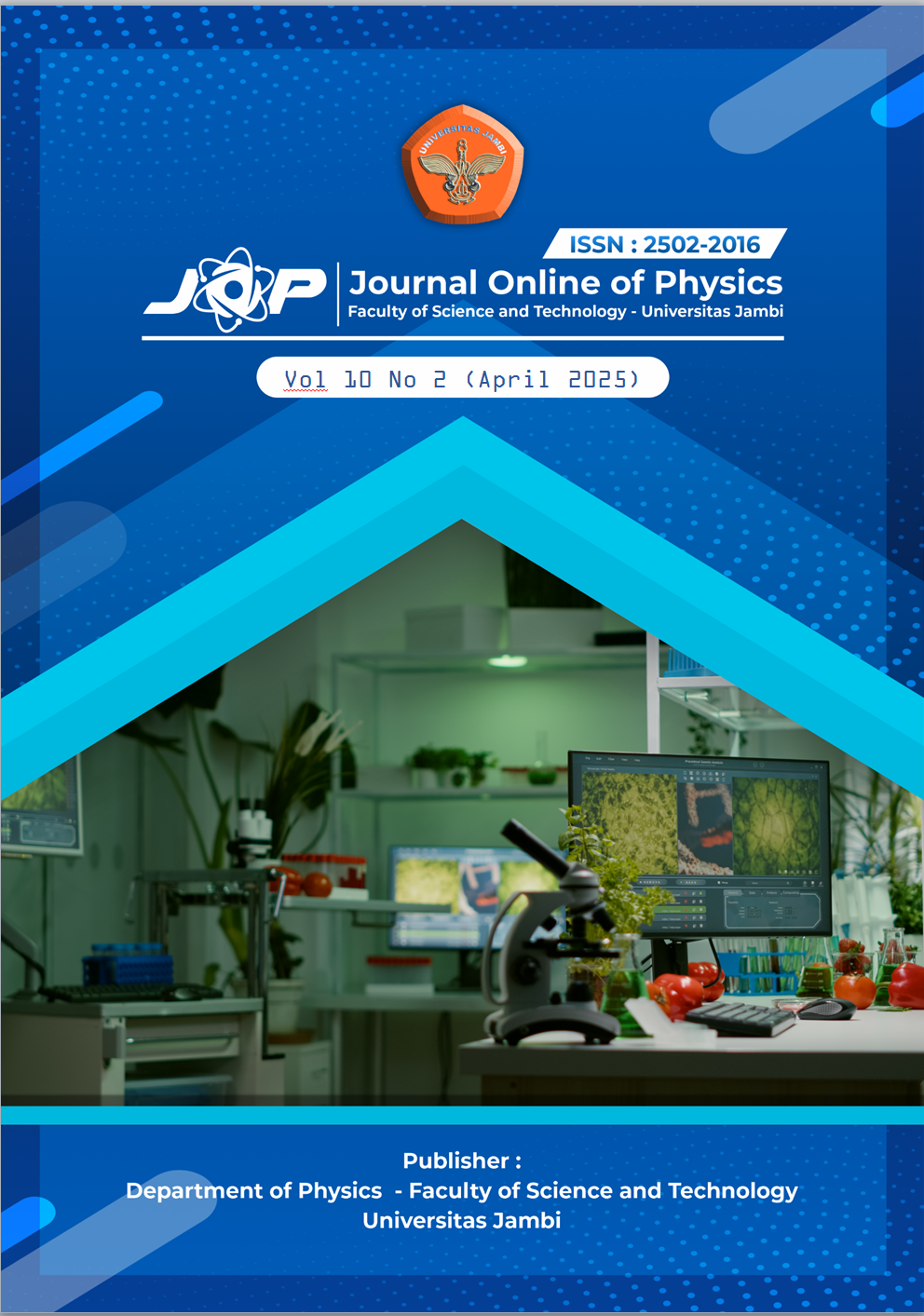STUDY OF DOS (DENSITY OF STATE) OF HALIDE PEROVSKITES CH3NH3PbI3 USING TROTTER-SUZUKI TIME PROPAGATION METHOD
DOI:
https://doi.org/10.22437/jop.v10i2.41224Keywords:
tight-binding, Density of States, Trotter-Suzuki decomposition, electronic structureAbstract
This study investigates the electronic properties of CH₃NH₃PbI₃ using the tight-binding time propagation method (TB-TPM) combined with the Trotter-Suzuki decomposition. The research focuses on computing the density of states (DOS) for various system sizes and time step parameters, employing a real-space approach to model the electronic structures of the material. Considering only the s-orbitals of Pb and I atoms reduces the computational complexity, enabling efficient simulations. The results indicate a metallic behavior, deviating from the expected semiconducting properties reported in prior studies due to the exclusion of critical p-orbital interactions. The study also highlights the effect of timestep size on the accuracy of the correlation functions and DOS, emphasizing the need for smaller timesteps to resolve spectral features effectively.
Downloads
References
Ariasoca, T. A., Sholihun, & Santoso, I. (2019). Trotter-Suzuki-time propagation method for calculating the density of states of disordered graphene. Computational Materials Science, 156, 434–440. https://doi.org/10.1016/j.commatsci.2018.10.016
Balagurov, D. B., Malyshev, V. A., & Domínguez Adame, F. (2004). Phase coherence in tight-binding models with nonrandom long-range hopping. Physical Review B, 69(10). https://doi.org/10.1103/physrevb.69.104204
Bannow, L. C., Hader, J., Moloney, J. V., & Koch, S. W. (2019). Microscopic calculation of the optical properties and intrinsic losses in the methylammonium lead iodide perovskite system. APL Materials, 7(1), 011107. https://doi.org/10.1063/1.5078791
Boyer-Richard, S., Katan, C., Traoré, B., Scholz, R., Jancu, J.-M., & Even, J. (2016). Symmetry-Based Tight Binding Modeling of Halide Perovskite Semiconductors. The Journal of Physical Chemistry Letters, 7(19), 3833–3840. https://doi.org/10.1021/acs.jpclett.6b01749
Brivio, F., Walker, A. B., & Walsh, A. (2013). Structural and electronic properties of hybrid perovskites for high-efficiency thin-film photovoltaics from first-principles. APL Materials, 1(4), 042111. https://doi.org/10.1063/1.4824147
Goesten, M. G., & Hoffmann, R. (2018). Mirrors of Bonding in Metal Halide Perovskites. Journal of the American Chemical Society, 140(40), 12996–13010. https://doi.org/10.1021/jacs.8b08038
Kojima, A., Teshima, K., Shirai, Y., & Miyasaka, T. (2009). Organometal Halide Perovskites as Visible-Light Sensitizers for Photovoltaic Cells. Journal of the American Chemical Society, 131(17), 6050–6051. https://doi.org/10.1021/ja809598r
Kovalenko, M. V., Protesescu, L., & Bodnarchuk, M. I. (2017). Properties and potential optoelectronic applications of lead halide perovskite nanocrystals. Science, 358(6364), 745–750. https://doi.org/10.1126/science.aam7093
Kresse, G., & Furthmüller, J. (1996). Efficient iterative schemes forab initiototal-energy calculations using a plane-wave basis set. Physical Review B, 54(16), 11169–11186. https://doi.org/10.1103/physrevb.54.11169
Nestoklon, M. O. (2020). Tight-binding description of inorganic lead halide perovskites in cubic phase. arXiv preprint arXiv:2012.14705.
Noh, J. H., Im, S. H., Heo, J. H., Mandal, T. N., & Seok, S. I. (2013). Chemical Management for Colorful, Efficient, and Stable Inorganic–Organic Hybrid Nanostructured Solar Cells. Nano Letters, 13(4), 1764–1769. https://doi.org/10.1021/nl400349b
Paolo Umari, Mosconi, E., & Angelis, F. D. (2021). Relativistic GW calculations on CH3NH3PbI3 and CH3NH3SnI3 perovskites for solar cell applications. Unboundmedicine.com. https://www.unboundmedicine.com/medline/citation/24667758/Relativistic_GW_calculations_on_CH3NH3PbI3_and_CH3NH3SnI3_perovskites_for_solar_cell_applications_
Perdew, J. P., Burke, K., & Ernzerhof, M. (1996). Generalized Gradient Approximation Made Simple. Phys. Rev. Lett., 77(18), 3865–3868. https://doi.org/10.1103/physrevlett.77.3865
S. Ashhab, O. Voznyy, Hoogland, S., Sargent, E. H., & Madjet, M. E. (2017). Effect of disorder on transport properties in a tight-binding model for lead halide perovskites. Scientific Reports, 7(1). https://doi.org/10.1038/s41598-017-09442-4
Shi, D., Adinolfi, V., Comin, R., Yuan, M., Alarousu, E., Buin, A., Chen, Y., Hoogland, S., Rothenberger, A., Katsiev, K., Losovyj, Y., Zhang, X., Dowben, P. A., Mohammed, O. F., Sargent, E. H., & Bakr, O. M. (2015). Low trap-state density and long carrier diffusion in organolead trihalide perovskite single crystals. Science, 347(6221), 519–522. https://doi.org/10.1126/science.aaa2725
Slater, J. C., & Koster, G. F. (1954). Simplified LCAO Method for the Periodic Potential Problem. Physical Review, 94(6), 1498–1524. https://doi.org/10.1103/physrev.94.1498
Suzuki, M. (1990). Fractal decomposition of exponential operators with applications to many-body theories and Monte Carlo simulations. Physics Letters A, 146(6), 319–323. https://doi.org/10.1016/0375-9601(90)90962-n
Wang, H., Wang, X., Zhang, H., Ma, W., Wang, L., & Zong, X. (2020). Organic−inorganic hybrid perovskites: Game-changing candidates for solar fuel production. Nano Energy, 71, 104647. https://doi.org/10.1016/j.nanoen.2020.104647
Wang, Y., Gould, T., Dobson, J. F., Zhang, H., Yang, H., Yao, X., & Zhao, H. (2014). Density functional theory analysis of structural and electronic properties of orthorhombic perovskite CH₃NH₃PbI₃. Physical Chemistry Chemical Physics, 16(4), 1424-1429.
Welborn, M., Chen, J., & Van Voorhis, T. (2013). Densities of states for disordered systems from free probability. Physical Review B, 88(20). https://doi.org/10.1103/physrevb.88.205113
Downloads
Published
How to Cite
Issue
Section
License
Copyright (c) 2025 Teguh Iman Perdana, Sholihun Sholihun, Imam Santoso

This work is licensed under a Creative Commons Attribution 4.0 International License.











